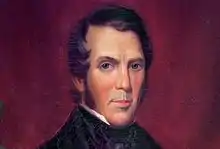Abraham Bruyn Hasbrouck
Abraham Bruyn Hasbrouck (November 29, 1791 – February 23, 1879) was a United States Congressman from New York and the sixth President of Rutgers College (now Rutgers University) serving from 1840 to 1850.[1][2] He was a slaveholder.[3]
Abraham Bruyn Hasbrouck | |
|---|---|
 | |
| 6th President of Rutgers University | |
| In office 1840–1840 | |
| Preceded by | Philip Milledoler |
| Succeeded by | Theodore Frelinghuysen |
| Member of the U.S. House of Representatives from New York's 7th district | |
| In office March 4, 1825 – March 3, 1827 | |
| Preceded by | Lemuel Jenkins |
| Succeeded by | George O. Belden |
| Personal details | |
| Born | November 29, 1791 Kingston, New York, U.S. |
| Died | February 23, 1879 (aged 87) Kingston, New York, U.S. |
| Spouse |
Julia Frances Ludlum
(m. 1819; died 1869) |
| Children | 2 |
Biography
He was born in 1791 in Kingston, New York, to Jonathan Hasbrouck (1763–1846) and Catherine Wynkoop (1763–1846).[4][1]
He studied at the Kingston Academy in Kingston, New York before entering Yale College where he graduated in 1810. Studying the law under Tapping Reeve, Elisha Williams, and James Gould, he returned to Kingston, New York, in 1814 to practice law. In 1817 he started a law practice with Charles H. Ruggles.[1]
He married on September 12, 1819, to Julia Frances Ludlum (1795–1869), the sister of Judge Gabriel W. Ludlum. Together they had eight children, including a son: Jonathan Howard Bruyn Hasbrouck (1820–1899), and a daughter, Caroline Hone Hasbrouck (1830-1898), who married George H. Sharpe, also a Hasbrouck descendant.[1]
Hasbrouck was elected to the 19th United States Congress, holding office from March 4, 1825, to March 3, 1827. In 1840, he was appointed as the sixth president of Rutgers College. He was the first layman to hold the office. During his tenure as president, he taught rhetoric, constitutional Law, and political economy.[1]
He worked to gain more independence from the Dutch Reformed Church and added modern languages to the curriculum, and expanded scientific instruction to the curriculum. He resigned from the office in 1849. He remained in office until 1850 when Theodore Frelinghuysen was appointed as his successor.[1]
Hasbrouck retired to Kingston, New York, where he died of pneumonia on February 23, 1879.[1][4]
Legacy
Abraham Bruyn Hasbrouck was a descendant of the Hasbroucks who founded New Paltz in 1678. The Hasbroucks were Huguenots, Protestant followers of John Calvin who fled what is today Northern France and South Belgium who fled persecution by the ruling Catholics. The original settlement of their ancestors survives today as Historic Huguenot Street, a National Historic Landmark District.
A street named after him in both Newburgh and Kingston, New York. The street in Kingston is named "Abruyn," because of the way he would sign his name, "A. Bruyn Hasbrouck," to differentiate himself from his first cousin, Abraham J. Hasbrouck.
References
- "Abraham Bruyn Hasbrouck". Rutgers University. Retrieved August 26, 2007.
Abraham Bruyn Hasbrouck was born in Kingston, New York, studied at Kingston Academy before entering Yale College where he graduated in 1810. Hasbrouck attended the private law school in Litchfield, Connecticut, where he received instruction in the common law from Tapping Reeve and James Gould. He returned to Kingston and in 1814 began his law practice. Hasbrouck served as President of the Ulster County Bank from its inception in 1831. In 1824 he was elected to Congress where he supported Henry Clay's policy of internal improvements.
- "Abraham Bruyn Hasbrouck". Officers and Alumni of Rutgers College (Originally Queen's College) in n New Brunswick, N. J, 1766 To 1916. Rutgers University. 1916. Retrieved January 18, 2018.
- Weil, Julie Zauzmer; Blanco, Adrian; Dominguez, Leo (January 20, 2022). "More than 1,700 congressmen once enslaved Black people. This is who they were, and how they shaped the nation". Washington Post. Retrieved January 30, 2022.
- "Hon. Abraham Bruyn Hasbrouck". The New York Times. February 24, 1879.